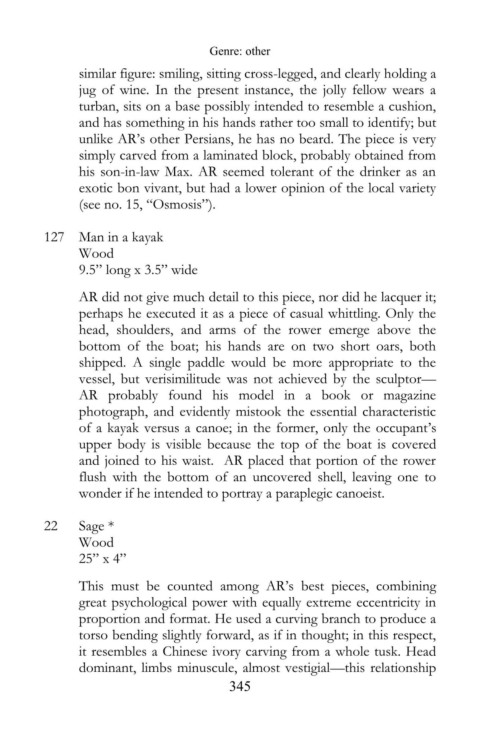Page 349 - The Legacy of Abraham Rothstein - text
P. 349
Genre: other
similar figure: smiling, sitting cross-legged, and clearly holding a
jug of wine. In the present instance, the jolly fellow wears a
turban, sits on a base possibly intended to resemble a cushion,
and has something in his hands rather too small to identify; but
unlike AR’s other Persians, he has no beard. The piece is very
simply carved from a laminated block, probably obtained from
his son-in-law Max. AR seemed tolerant of the drinker as an
exotic bon vivant, but had a lower opinion of the local variety
(see no. 15, “Osmosis”).
127 Man in a kayak
Wood
9.5” long x 3.5” wide
AR did not give much detail to this piece, nor did he lacquer it;
perhaps he executed it as a piece of casual whittling. Only the
head, shoulders, and arms of the rower emerge above the
bottom of the boat; his hands are on two short oars, both
shipped. A single paddle would be more appropriate to the
vessel, but verisimilitude was not achieved by the sculptor—
AR probably found his model in a book or magazine
photograph, and evidently mistook the essential characteristic
of a kayak versus a canoe; in the former, only the occupant’s
upper body is visible because the top of the boat is covered
and joined to his waist. AR placed that portion of the rower
flush with the bottom of an uncovered shell, leaving one to
wonder if he intended to portray a paraplegic canoeist.
22 Sage *
Wood
25” x 4”
This must be counted among AR’s best pieces, combining
great psychological power with equally extreme eccentricity in
proportion and format. He used a curving branch to produce a
torso bending slightly forward, as if in thought; in this respect,
it resembles a Chinese ivory carving from a whole tusk. Head
dominant, limbs minuscule, almost vestigial—this relationship
345

